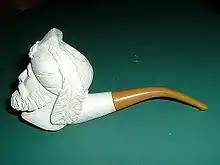Tobacco pipe
A tobacco pipe, often called simply a pipe, is a device specifically made to smoke tobacco. It comprises a chamber (the bowl) for the tobacco from which a thin hollow stem (shank) emerges, ending in a mouthpiece.[1] Pipes can range from very simple machine-made briar models to highly prized hand-made artisanal implements made by renowned pipemakers, which are often very expensive collector's items. Pipe smoking is the oldest known traditional form of tobacco smoking.[2]
History
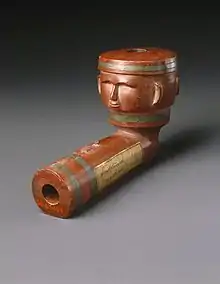
Some cultures of the indigenous peoples of the Americas smoke tobacco in ceremonial pipes, and have done so since long before the arrival of Europeans. For instance the Lakota people use a ceremonial pipe called čhaŋnúŋpa. Other cultures of the indigenous peoples of the Americas smoke tobacco socially.[3] The tobacco plant is native to South America but spread into North America long before Europeans arrived. Tobacco was introduced to Europe from the Americas in the 16th century and spread around the world rapidly.
As tobacco was not introduced to the Old World until the 16th century,[4] the older pipes outside of the Americas were usually used to smoke various other substances, including hashish, a rare and expensive substance outside areas of the Middle East, Central Asia and India, where it was then produced.
Workings of a tobacco pipe
Principle
A pipe's fundamental function is to provide a relatively safe, manipulable volume in which to incompletely combust a smokable substance. Typically this is accomplished by connecting a refractory 'bowl' to some sort of 'stem' which extends and may also cool the smoke mixture drawn through the combusting organic mass (see below).
Parts

The broad anatomy of a pipe typically comprises mainly the bowl and the stem. The bowl (1) which is the cup-like outer shell, the part hand-held while packing, holding and smoking a pipe, is also the part "knocked" top-down to loosen and release impacted spent tobacco. On being sucked, the general stem delivers the smoke from the bowl to the user's mouth.
Inside the bowl is an inner chamber (2) space holding tobacco pressed into it. This draught hole (3), is for air flow where air has travelled through the tobacco in the chamber, taking the smoke with it, up the shank (4). At the end of the shank, the pipe's mortise (5) and tenon (6) joint is an air-tight, simple connection of two detachable parts where the mortise is a hole met by the tenon, a tight-fitting "tongue" at the start of the stem (7). Known as the bore (10), the inner shaft of this second section stays uniform throughout while the outer stem tapers down to the mouthpiece or bit (8) held in the smoker's teeth, and finally ends in the "lip" (9), attenuated for comfort.
Materials
The bowls of tobacco pipes are commonly made of briar wood, meerschaum, corncob, pear-wood, rose-wood or clay. Less common materials include other dense-grained woods such as cherry, olive, maple, mesquite, oak, and bog-wood. Minerals such as catlinite and soapstone have also been used. Pipe bowls are sometimes decorated by carving, and moulded clay pipes often had simple decoration in the mould.
Unusual pipe materials include gourds (as in the famous calabash pipe) and pyrolytic graphite. Metal and glass, seldom used for tobacco pipes, are common for pipes intended for other substances, such as cannabis.
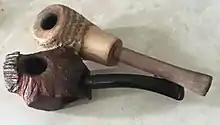

The stem needs a long channel of constant position and diameter running through it for a proper draw, although filter pipes have varying diameters and can be successfully smoked even without filters or adapters. Because it is molded rather than carved, clay may make up the entire pipe or just the bowl; pipes made of most other materials have stems constructed separately and detachable. Stems and bits of tobacco pipes are usually made of moldable materials like Ebonite, Lucite, Bakelite, or soft plastic. Less common are stems made of reeds, bamboo, or hollowed-out pieces of wood. Expensive pipes once had stems made of amber, though this is rare now.
Types
Pipe shapes
- Apple. Subtypes: Apple, Author, Diplomat, Egg, Hawkbill, Prince, Tomatoe (Ball).
- Billiard. Subtypes: Billiard, Brandy, Chimney, Panel, Oom Paul, Pot, Nose Warmer.
- Bulldog. Subtypes: Bulldog, Bull Moose, Bullcap, Rhodesian, Ukulele.
- Calabash. Subtypes: Calabash, Reverse Calabash.
- Canadian. Subtypes: Canadian, Liverpool, Lovat, Lumberman.
- Cavalier. Subtypes: Cavalier, Pseudo-cavalier.
- Churchwarden (Reading pipe). – Pipe with a long stem.
- Dublin. Subtypes: Dublin, Acorn (Pear), Cutty, Devil Anse, Zulu.
- Freehand. Subtypes: Freehand, Blowfish, Horn, Nautilus, Tomahawk, Volcano.
- Sitter. Subtypes: Sitter, Cherrywood, Duke (Don), (Stand Up) Poker, Tankard.
- Tyrolean pipe.
- Vest Pocket.
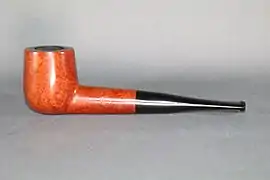 Billiard
Billiard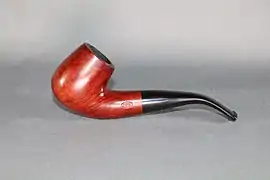 Bent (Billiard)
Bent (Billiard) Sitter
Sitter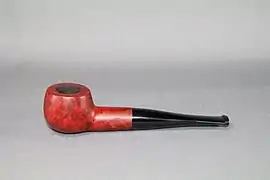 Pot
Pot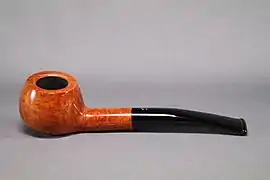 Prince
Prince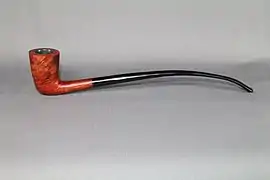 Churchwarden
Churchwarden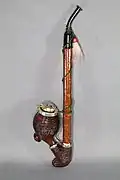 Tyrolean
Tyrolean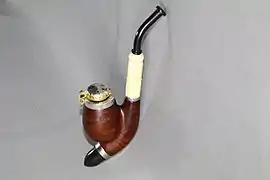 Cavalier
Cavalier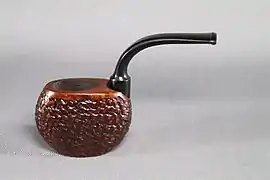 Vest Pocket
Vest Pocket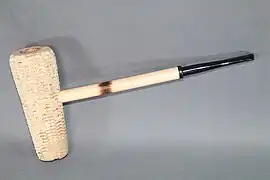 MacArthur
MacArthur
Calabash
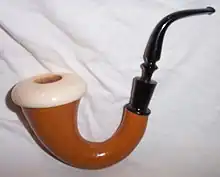
Calabash gourds (usually with meerschaum or porcelain bowls set inside them) have long made prized pipes, but they are labour-intensive and, today, quite expensive. Because of this expense, pipes with bodies made of wood (usually mahogany) instead of gourd, but with the same classic shape, are sold as calabashes. Both wood and gourd pipes are functionally the same (with the important exception that the dried gourd, usually being noticeably lighter, sits more comfortably in the mouth). They consist of a downward curve that ends with an upcurve where the bowl sits. Beneath the bowl is an air chamber which serves to cool, dry, and mellow the smoke. There are also briar pipes being sold as calabashes. These typically do not have an air chamber and are so named only because of their external shape.
A calabash pipe is rather large and easy to recognize as a pipe when used on a stage in dramatic productions. Although a British newspaper cartoon of the early 1900s depicts the British actor H. A. Saintsbury as the Great Detective smoking what may be a calabash pipe, its now-stereotypical identification with Sherlock Holmes remains a mystery.
Some commentators have erroneously associated the calabash with William Gillette, the first actor to become universally recognized as the embodiment of the detective. Gillette actually introduced the curving or bent pipe for use by Holmes, but his pipe was an ornate briar. Gillette chose a bent pipe, more easily clenched in the teeth when delivering lines.
While there are promotional stills of Basil Rathbone smoking calabash pipes as Holmes for other projects, most notably his radio show, in his first two outings as Holmes produced by 20th Century-Fox as taking place in the Victorian era, Rathbone smoked an apple-bowled, black briar with a half bend, made by Dunhill, the company known for making the best pipes at that time. In the next dozen films, the series produced by Universal Studios, with Holmes and Watson updated to the 1940s, Rathbone smokes a much less expensive Peterson half bend with a billiard-shaped bowl. A calabash is introduced in The Spider Woman but Holmes does not smoke it.
In the original chronicles, such as "The Adventure of the Copper Beeches", Sherlock Holmes is described as smoking a long-stemmed cherrywood, which he favored "when in a disputatious, rather than a meditative mood." Holmes smokes an old briar-root pipe on occasion, for example in The Sign of the Four, and an "unsavory" and "disreputable" black and oily clay pipe in several stories, notably in "The Red-Headed League". Dr Watson declares it to be the detective's preferred pipe: "It was to him as a counsellor" (A Case of Identity), the "companion of his deepest meditations" (The Valley of Fear)..
Pipes with removable bowl
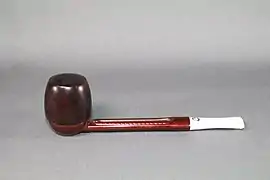 Falcon pipe.
Falcon pipe.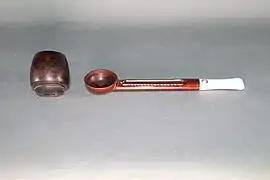 Falcon pipe with bowl detached.
Falcon pipe with bowl detached. Falcon pipe.
Falcon pipe.
Bowls are made of varying shapes and materials to allow the smoker to try different characteristics or to dedicate particular bowls for particular tobaccos. Bowls are not interchangeable between manufacturers.
Hookahs

A hookah, ghelyan, or narghile, is a Middle Eastern water pipe that cools the smoke by filtering it through a water chamber. Often ice, cough-drops, milk, or fruit juice is added to the water. Traditionally, the tobacco is mixed with a sweetener, such as honey or molasses. Fruit flavors have also become popular. Modern hookah smokers, especially in the US, smoke "me'assel", "moassel", "molasses" or "shisha", all names for the same wet mixture of tobacco, molasses/honey, glycerine, and often, flavoring. This style of tobacco is smoked in a bowl with foil or a screen (metal or glass) on top of the bowl. More traditional tobaccos are "tombiek" (a dry unflavored tobacco, which the user moistens in water, squeezes out the extra liquid, and places coals directly on top) or "jarak" (more of a paste of tobacco with fruit to flavor the smoke).
Bowl materials
North American natives along the East coast traditionally made their tobacco pipes from clay or from a type of pot-stone (lapis ollaris), or else serpentine stone.[5] In the Upper Midwest they made use of the red pipestone or catlinite for the same,[6] a fine-grained easily worked stone of a rich red color of the Coteau des Prairies. Today, other construction materials used for the bowl may include any of the following:
- Briar – root of Erica arborea, prevalent material.
- Meerschaum – mineral sepiolite called "sea foam".
- Gourd
- Porcelain
- Synthetics
- Ebony ("Zappi")
- Cherry wood
- Beechwood
- Corn cob
- Metal – used by Japanese kiseru and Arabian midwakh.
 Briar
Briar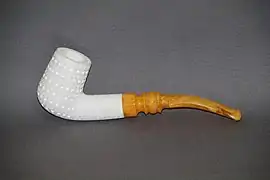 Meerschaum
Meerschaum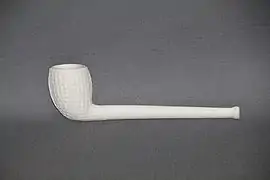 Clay
Clay Cherry wood
Cherry wood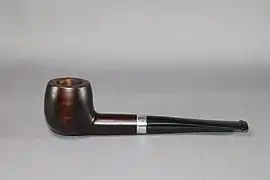 Beechwood
Beechwood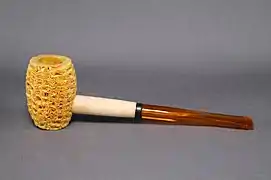 Corn cob
Corn cob Porcelain
Porcelain
Briar

The majority of pipes sold today, whether handmade or machine-made, are fashioned from briar. Briar is a particularly well suited wood for pipe making for a number of reasons. The first and most important characteristic is its natural resistance to fire. The second is its inherent ability to absorb moisture. The burl absorbs water in nature to supply the tree in the dry times and likewise will absorb the moisture that is a byproduct of combustion. Briar is cut from the root burl of the tree heath (Erica arborea), which is native to the rocky and sandy soils of the Mediterranean region. Briar burls are cut into two types of blocks; ebauchon and plateaux. Ebauchon is taken from the heart of the burl while plateaux is taken from the outer part of the burl. While both types of blocks can produce pipes of the highest quality, most artisan pipemakers prefer to use plateaux because of their superior graining.
Clay
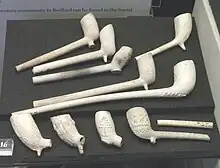
Ceramic pipes, made of moulded and then fired clay, were used almost universally by Europeans between the introduction of tobacco in the 16th century, and the introduction of cheap cigarettes at the end of the nineteenth.[7]
The material is not very strong and the early varieties had long thin stems, so they frequently broke, but were cheap to replace. It has been claimed that this fragility was somewhat intentional as it was utilized by Colonial American tavern keepers, for example, in renting the clay pipes to patrons. When the patron was done smoking the pipe and returned it to the keeper, the end of the stem was simply broken off so as to be ready for the next patron. However, there is no documentary evidence for this practice; it is known that communal pipes used in taverns were cleansed by being heated in an oven on special iron racks.[8]
In England clay pipes were sold in bundles of dozens or twenties, and were often free in taverns, where the tobacco was sold.
Forming the pipe involved making them in moulds with the bore created by pushing an oiled wire inside the stem. The preferred material was pipeclay or "tobacco pipe clay", which fires to a white colour and is found in only certain locations. In North America, many clay pipes were historically made from more typical terracotta-coloured clays. According to one British writer in 1869, the French preferred old pipes and the English new, the middle class preferred long stems and the working class preferred short.[9] Short stemmed pipes, sometimes called cuttys or nose warmers in England, were preferred by manual laborers as they could be gripped between the teeth, leaving both of the smoker's hands free.[7]
Later low-quality clay pipes were made by slip casting in a mould. Higher quality pipes are made in a labour-intensive hand shaping process.[10] Traditionally, clay pipes are unglazed. Clays burn "hot" in comparison to other types of pipes, so they are often difficult for most pipe-smokers to use. Their proponents claim that, unlike other materials, a well-made clay pipe gives a "pure" smoke with no flavour addition from the pipe bowl. In addition to aficionados, reproductions of historical clay styles are used by some historical re-enactors. Clay pipes were once very popular in Ireland, where they were called dudeens.
Broken fragments of clay pipe can be useful as dating evidence for archaeologists. English specialists can date a pipe to around a 20-year period. In the 1950s, the American archaeologist J. C. Harrington noted that the bore of pipe stems decreased over time, so a late sixteenth or early seventeenth centuries pipe would have a stem bore diameter of around 9⁄64 inch (3.6 mm), but a late eighteenth century pipe would have a bore diameter of around 4⁄64 inch (1.6 mm). The size of bowls also increased over time as tobacco became a cheaper commodity, and later pipes tend to be more decorated.[7][11]
Corncob

The uniquely American pipes made from corncobs are cheap and effective, although regarded by some as inelegant. After being dried for two years, the cobs are hollowed out to form a bowl shape, then either dipped in a plaster-based mixture or varnished or lacquered on the outside. Shanks made from birch wood are then inserted into the bowls.
The world's oldest and largest manufacturer of corncob pipes is Missouri Meerschaum, located in Washington, Missouri, where the company has produced the pipes since 1869.[12] General Douglas MacArthur and Mark Twain were perhaps the most famous historical smokers of corncob pipes, as well as fictional cartoon characters Popeye and Frosty the Snowman.
Corncob pipes remain popular because they are inexpensive and require no "break-in" period like briar pipes.[13][14] Owing to these factors, corncob pipes are often recommended as a "beginner's pipe".[15] Additionally, pipesmokers who wish to sample different tobaccos and blends might keep a stock of corncobs on hand to permit them to try new flavors without "carryover" from an already-used pipe, or to prevent a potentially bad-tasting tobacco from adding its flavor to a more expensive or favored pipe.[16]
Meerschaum
Meerschaum (hydrated magnesium silicate), a mineral found in small shallow deposits mainly around the city of Eskişehir in central Turkey, is prized for the properties which allow it to be carved into finely detailed decorative and figural shapes. It has been used since the 17th century and, with clay pipes, represented the most common medium for pipes before the introduction of briar as the material of choice in the 19th century. The word "meerschaum" means "sea foam" in German, alluding to its natural white color and its surprisingly low weight. Meerschaum is a very porous mineral that absorbs elements of the tobacco during the smoking process, and gradually changes color to a golden brown. Old, well-smoked meerschaum pipes are valued by collectors for their distinctive coloring.
Meerschaum pipes can either be carved from a block of meerschaum, or made from meerschaum dust collected after carving and mixed with a binder then pressed into a pipe shape. The latter are far less absorbent, color in blotches, and lack the smoking quality of the block carved pipe.[17][18]
Synthetics

A variety of other materials may also be used for pipes. The Redmanol corporation manufactured pipes with translucent stems in the 1920s and a series of pipes were manufactured and distributed by the Tar Gard (later Venturi) Corporation of San Francisco from 1965 to 1975. Marketed under names such as "the pipe", "The Smoke" and "Venturi", they used materials such as pyrolytic graphite, phenolic resin, nylon, Bakelite and other synthetics, allowing for higher temperatures in the bowl, reduced tar, and aesthetic variations of color and style.[19] After Venturi stopped making pipes, several companies continue to make pipes from Brylon, a composite of nylon and wood flour, as a cheaper substitute for briar.
Briar bowl finish types
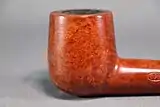
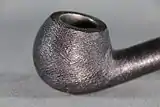

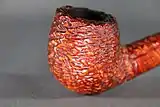
- Brushed
- Carved
- Rustic
- Sandblast
- Smooth
Corn cob bowl finish types
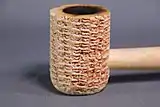
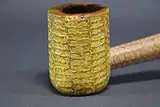
- Natural
- Stained
- Varnished (Polished)
Chamber types
- Important is size – diameter and depth.
- Chamber can be lined with other material, usually meerschaum or metal.
Tenon shapes
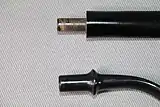
- Army – Enables the pipe smoker to remove the stem from the shank while hot without fear of warping. Is often seen with a metal band around the shank.
- Screw – Also allows for the immediate removal of the stem from the shank for cleaning while still hot. Often seen on pipes with stingers, allowing the pipe smoker to clean the stinger while still hot, making the task much easier.
- Standard
Filter types
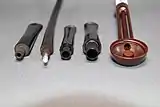

- None
- Cooler (Stinger)
- 6 mm
- 9 mm
- Other, e.g. Falcon dry ring.
Stem materials

- Acrylic
- Amber
- Bakelite
- Cumberland (Brindle)
- Ebonite
- Horn (Keratin)
- Plastic
- Metal, e.g. Aluminium. Metal stem serves as a heat sink.
Stem shapes
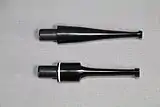
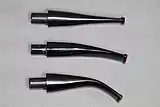
- Combination
- Saddle
- Tapered
Stem curvatures
- Straight
- Slightly bent (semi-straight, half bent)
- Bent
Bit shapes


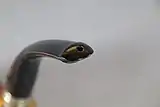
- Denture
- Fishtail
- P-lip
- Standard
Bit sizes
- Regular (single bore)
- Double bore
- Wide comfort
- Double comfort
Accessories
Filters
Used to absorb moisture, tar and nicotine. Made of:
- Paper
- Balsa wood
- Meerschaum
- Charcoal (activated carbon)
- Other, e.g. Falcon dry ring or Denicool filter crystals.
Filters can be single- or double-sided. Double-sided filter has both ends ceramic that can withstand hot smoke. Single-sided filter has ceramic end to the bowl and plastic end to the stem.
 Smoking pipe filters. Left to right: 6 mm paper. 6 mm charcoal. 9 mm paper. 9 mm charcoal one-sided. 9 mm meerschaum. 9 mm balsa wood. Falcon dry ring.
Smoking pipe filters. Left to right: 6 mm paper. 6 mm charcoal. 9 mm paper. 9 mm charcoal one-sided. 9 mm meerschaum. 9 mm balsa wood. Falcon dry ring. Smoking pipe filters.
Smoking pipe filters. Disassembled smoking pipe filter. 9 mm paper.
Disassembled smoking pipe filter. 9 mm paper. Disassembled smoking pipe filter. 9 mm charcoal. One-sided.
Disassembled smoking pipe filter. 9 mm charcoal. One-sided. Disassembled smoking pipe filter. 9 mm meerschaum.
Disassembled smoking pipe filter. 9 mm meerschaum. Smoking pipe filter crystals.
Smoking pipe filter crystals.
Use
Smoking a pipe requires more apparatus and technique than cigarette or even cigar smoking. In addition to the pipe itself and matches or a pipe lighter, smokers usually require a pipe tool for packing, adjusting, and emptying the tobacco in the bowl, and a regular supply of pipe cleaners. In 18th-century North American material culture, tobacco was pressed down into the chamber of the bowl by way of a "tobacco-stopper" and which often consisted of a bone extracted from the male parts of a raccoon.[20]
Tobacco

Tobaccos for smoking in pipes are often carefully treated and blended to achieve flavour nuances not available in other tobacco products. Many of these are blends using staple ingredients of variously cured Burley and Virginia tobaccos which are enhanced by spice tobaccos, among them many Oriental or Balkan varietals, Latakia (a fire-cured spice tobacco of Syrian origin, but now made in other regions, such as, Cyprus and Lebanon ), Perique (uniquely grown in St. James Parish, Louisiana) which is also an old method of fermentation, or blends of Virginia and Burley tobaccos of African, Indian, or South American origins. Traditionally, many U.S. blends are made of American Burley with sweeteners and flavorings added to create an "aromatic" flavor, whereas "English" blends are based on natural Virginia tobaccos enhanced with Oriental and other natural tobaccos. There is a growing tendency towards "natural" tobaccos which derive their aromas from artful blending with selected spice tobaccos only and careful, often historically-based, curing processes.
Pipe tobacco can be purchased in several forms, which vary both in flavour (leading to many blends and opportunities for smokers to blend their own tobaccos) and in the physical shape and size to which the tobacco has been reduced. Most pipe tobaccos are less mild than cigarette tobacco, substantially more moist and cut much more coarsely. Too finely cut tobacco does not allow enough air to flow through the pipe, and overly dry tobacco burns too quickly with little flavour. Pipe tobacco must be kept in an airtight container, such as a canning jar or sealed tin, to keep from drying out.
Some pipe tobaccos are cut into long narrow ribbons. Some are pressed into flat plugs which are sliced into flakes. Others are tightly wound into long ropes, then sliced into discs. Plug tobacco is maintained in its pressed block form and sold in small blocks. The plug will be sliced into thin flakes by the smoker and then prepared in a similar fashion to flake tobacco. It is considered that plug tobacco holds its flavor better than rubbed or flake tobacco. Flake tobacco (sliced cakes or ropes) may be prepared in several ways. Generally it is rubbed out with the fingers and palms until it is loose enough to pack. It can also be crumbled or simply folded and stuffed into a pipe. Some people also prefer to dice up very coarse tobaccos before using them, making them easier to pack.
Packing
In the most common method of packing, tobacco is added to the bowl of the pipe in several batches, each one pressed down until the mixture has a uniform density that optimizes airflow (something that it is difficult to gauge without practice). This can be done with a finger or thumb, but if the tobacco needs to be repacked later, while it is burning, the tamper on a pipe tool is sometimes used. If it needs to be loosened, the reamer, or any similar long pin can be used. A traditional way of packing the pipe is to fill the bowl and then pack gently to about 1⁄3 full, fill again and pack slightly more firmly to about 2⁄3 full, and then pack more firmly still to the top.
An alternative packing technique called the Frank method involves lightly dropping tobacco in the pipe, after which a large plug is gingerly pushed into the bowl all at once.
Lighting
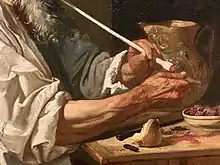

Matches, or separately lit slivers of wood are often considered preferable to lighters because of lower burning temperature. Butane lighters made specifically for pipes emit flame sideways or at an angle to make it easier to direct flame into the bowl. Torch-style lighters should never be used to light a pipe because their flames are too hot and can char the rim of the pipe bowl. Matches should be allowed to burn for several seconds to allow the sulfur from the tip to burn away and the match to produce a full flame. A naphtha fueled lighter should also be allowed to burn a few seconds to get rid of stray naphtha vapors that could give a foul taste to the smoke. When a flame has been produced, it is then moved in circles above the rim of the bowl while the smoker puffs to draw the flame down and light the tobacco. Packing method and humidity can affect how often a pipe must be relit.
Burning prevention
With care, a briar pipe can last a very long time without burning out. However, due to aggressive (hot) smoking or imperfections in the wood, a hole can be burned in the tobacco chamber of the pipe. There are several methods used to help prevent a wood pipe from burning out. These generally involve coating the chamber with any of a variety of substances, or by gently smoking a new pipe to build up a cake (a mixture of ash, unburned tobacco, oils, sugars, and other residue) on the walls.
These coatings may include honey and water; powdered sugar and water; cigar ash and water; and sour cream, buttermilk, and activated charcoal among many others.
Many modern briar pipes are pre-treated by the manufacturer to resist burning. If smoked correctly, the cake will build up properly on its own. Another technique is to alternate a half-bowl and a full-bowl the first several times the pipe is used to build an even cake. Burley is often recommended to help a new pipe build cake.
The caked layer that helps prevent burning through the bottom or sides of a briar wood pipe may damage other pipes, such as meerschaum or clay. As the cake layer heats up, it expands and may cause cracks or breaks in non-briar pipes.
Smoking
Pipe smoke, like cigar smoke, is usually not inhaled. It is merely brought into the mouth, pumped around oral and nasal cavities to permit absorption of nicotine toward the brain through the mucous membranes, and released. It is normal to have to relight a pipe periodically. If it is smoked too slowly, this will happen more often. If it is smoked too quickly, it can produce excess moisture causing a gurgling sound in the pipe and an uncomfortable sensation on the tongue (referred to as "pipe tongue", or more commonly, "tongue bite").
A pipe cleaner can be used to dry out the bowl and, wetted with alcohol, the inner channel. The bowl of the pipe can also become uncomfortably hot, depending on the material and the rate of smoking. For this reason, clay pipes in particular are often held by the stem. Meerschaum pipes are held in a square of chamois leather, with gloves, or else by the stem in order to prevent uneven coloring of the material.
 Man smoking by Fritz Wagner
Man smoking by Fritz Wagner A pipe-smoking woman
A pipe-smoking woman
Cleaning

The ash and the last bits of unburned tobacco, known as dottle, should be cleaned out with a suitable pipe tool. A soft or bristle pipe cleaner, which may be moistened with strong spirits, is then run through the airways of the stem and shank to remove any moisture, ash, and other residue before the pipe is allowed to dry. A pipe should be allowed to cool before removing the stem to avoid the possibility of warping it.
A cake of ash eventually develops inside the bowl. This is generally considered desirable for controlling overall heat. However, if it becomes too thick, it may expand faster than the bowl of the pipe itself when heated, cracking the bowl. Before reaching this point, it needs to be scraped down with a reamer. It is generally recommended to keep the cake at approximately the thickness of a U.S. dime (about 1/20 of an inch or 1.5 mm), though sometimes the cake is removed entirely as part of efforts to eliminate flavors or aromas.
Cake is considered undesirable in meerschaum pipes because it can easily crack the bowl or interfere with the mineral's natural porosity. Meerschaum also softens when heated so it is recommended to allow meerschaum pipes to cool before cleaning as people have been known to push pipe cleaners through the walls of heated pipes.
Regardless whether a pipe is cleaned after every smoke, over time there is a buildup of cake in the bowl and tars in the internals of a smoking pipe. The cake can be controlled by gentle reaming, but a buildup of tars in the shank and airway of a pipe is more difficult to deal with. This may require the services of a professional pipe restorer to properly clean and sanitize the pipe.[21]
Sweetening
When tobacco is burned, oils from adjoining not yet ignited particles vaporize and condense into the existing cake on the walls of the bowl and shank. Over time, these oils can oxidize and turn rancid, causing the pipe to give a sour or bitter smoke. A purported countermeasure involves filling the bowl with kosher salt and carefully wetting it with strong spirits. It is important to not use iodized salt, as the iodine and other additives may impart an unpleasant flavor. Regularly wiping out the bowl with spirits such as vodka or rum is helpful in preventing souring. Commercial pipe-sweetening products are also available.
See also
References
- southcapenet (2020-12-25). "A brief history of the Smoking Pipe". Ebenharts Handmade Pipes & Restaurant. Retrieved 2022-10-03.
- southcapenet (2020-12-25). "A brief history of the Smoking Pipe". Ebenharts Handmade Pipes & Restaurant. Retrieved 2022-10-03.
- ""Episode 11 Tobacco Pipes" by Robert Cassanello". stars.library.ucf.edu. Retrieved 2016-01-11.
- Davey, Mike. "The European Tobacco Trade From the 15th to the 17th Centuries". University of Minnesota. Archived from the original on 6 November 2018. Retrieved 31 December 2017.
- Kalm, Pehr (1772). Travels into North America: containing its natural history, and a circumstantial account of its plantations and agriculture in general, with the civil, ecclesiastical and commercial state of the country, the manners of the inhabitants, and several curious and important remarks on various subjects. Translated by Johann Reinhold Forster. London: T. Lowndes. p. 344. ISBN 9780665515002. OCLC 1083889360.
- "Catlinite, Calumet Pipes and Pipestone National Monument". Maps, Material, Culture, and Memory: On the Trail of the Ioway. University of Iowa. Archived from the original on 3 July 2015. Retrieved 20 August 2015.
- "Evolution of clay tobacco pipes in England" (PDF). Cambridge Archaeology Field Group. November 2012. Retrieved 2018-07-27.
- Hume, Ivor Noël. "Hunting for a Little Ladle". The Colonial Williamsburg Foundation. The Colonial Williamsburg Foundation. Retrieved 12 February 2016.
- "The Bane without its Antidote", The Nautical Magazine and Naval Chronicle for 1869, reprint Cambridge University Press, 2013, ISBN 1108054870, 9781108054874, google books
- Newns, Sarah (2017). "The Clay Tobacco Pipes". Internet Archaeology (45). doi:10.11141/ia.45.3.4.
- McMillan, Lauren (July 2010). Put This in your Pipe and Smoke it: An Evaluation of Tobacco Pipe Stem Dating Methods (PDF) (Master of Arts thesis). East Carolina University.
- "History of Missouri Meerschaum Company - The world's oldest and largest manufacturer of corn cob pipes. - Washington, MO". corncobpipe.com. Archived from the original on 2001-05-09.
- "Some Brief Questions About Corn Cob Pipes :: General Pipe Smoking Discussion :: Pipe Smokers Forums". pipesmagazine.com. October 2013. Retrieved 2019-01-18.
- "How to break in a corn cob pipe". TobaccoPipes.com. Retrieved 2019-01-18.
- "Pipes for Beginners". Cigars International. Retrieved 2019-01-18.
- "Corn Cob Pipes: 7 Reasons to try one". TobaccoPipes.com. Retrieved 2019-01-18.
- "Large sizes in meerschaum". Amsterdam Pipe Museum. n.d. Retrieved 20 March 2022.
- "The Beginners Guide to Using and Buying a Meerschaum Pipes and What Tobacco is Best". Paykoc Imports. 29 November 2019.
- Taylor II, Ph.D., Billie W. "A History of the pipe: Manufacturing and Marketing Pyrolytic Graphite Pipes from Development to Demise". Retrieved 2010-08-21.
- Kalm, Pehr (1772). Travels into North America: containing its natural history, and a circumstantial account of its plantations and agriculture in general, with the civil, ecclesiastical and commercial state of the country, the manners of the inhabitants, and several curious and important remarks on various subjects. Translated by Johann Reinhold Forster. London: T. Lowndes. p. 76. ISBN 9780665515002. OCLC 1083889360.
- "It's All About The Aesthetics ....... Isn't It?". Archived from the original on 2014-11-11. Retrieved 10 November 2014.
Further reading
- Bayne-Jones, Stanhope, Burdette, Walter J., Cochran, William G., Farber, Emmanuel, Fieser, Louis F., Furth, Jacob, Hickam, John B., LeMaistre, Charles, Schuman, Leonard M., and Seevers, Maurice H. (January 11, 1964). "Smoking and Health: Report of the Advisory Committee to the Surgeon General of the Public Health Office". J. Natl. Cancer Inst. 96 (11): 853–61. CiteSeerX 10.1.1.520.3208. doi:10.1093/jnci/djh144. PMID 15173269.
{{cite journal}}: CS1 maint: multiple names: authors list (link)
- Henley, S. Jane, Thun, Michael J., Chao, Ann, and Calle, Eugenia E. (June 2, 2004). "Association Between Exclusive Pipe Smoking and Mortality From Cancer and Other Diseases". Journal of the National Cancer Institute. 96 (11): 853–861. doi:10.1093/jnci/djh144. PMID 15173269.
{{cite journal}}: CS1 maint: multiple names: authors list (link) - The Columbia Encyclopedia, Sixth Edition. 2001-05.
External links
| Library resources about Tobacco pipes |

